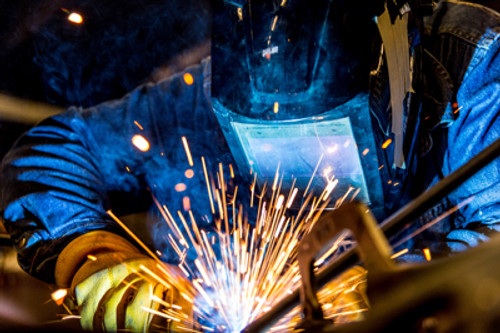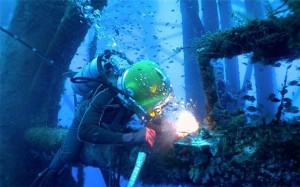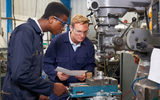What Is The Best Protection Against Welding Hazards?
The history of joining different metals together dates back to the Bronze Age. But it wasn't until the end of the 19th century that the only welding process that existed was forge welding. Welding is a process that joins materials together by melting a metal piece with a filler metal to form a strong joint.
Today, the most common types of welding processes are:
- Shielded Metal Arc Welding (SMAW), or Manual Metal Arc Welding (MMAW)
- Gas Tungsten Arc Welding (GTAW), or Tungsten Inert Gas (TIG) Welding
- Flux Cored Arc Welding (FCAW)
- Gas Metal Arc Welding (GMAW), or Metal Inert Gas (MIG) Welding
- Plasma Arc Welding (PAW), Plasma Arc Cutting (PAC) and Gouging
- Resistance Welding (RW) or spot welding
- Air Carbon Arc Cutting and Gouging
- Submerged Arc Welding (SAW)
- Oxyfuel Welding, Cutting and Heating
Below is a table of safety hazards existing in different types of welding operations, and the recommendations on how to prevent injuries.
Welding Safety Hazards and Protective Measures
| TYPES OF HAZARDS | MPAW/PAC, Air Carbon Arc Processes | SMAW, GTAW, GMAW, FCAW | SAW | OXYFUEL |
PROTECTIVE MEASURES |
|---|---|---|---|---|---|
| Ergonomic | Y | Y | Y | Y | Use proper lifting techniques, foot rest, knee pads, and take breaks, or frequently change position to prevent musculoskeletal injuries, minimize vibration, remove debris and clutter to avoid slips and falls |
| Electric Shock | Y | Y | Y | N | Inspect electrode holder for damage, do not touch electrically “hot” parts inside the welder case, keep welding cable and electrode holder insulation in perfect condition, use insulated tools, wear Arc Flash clothing, aprons, FR gloves, headwear and footwear. |
| Bright Light | Y | Y | Y | Y | Make sure you are wearing protective glasses with side shields, or a welding helmet with a dark lens. |
| UV Radiation | Y | Y | N | N | Wear UV protective clothing and headgear; the chart below indicates the correct lens shade numbers. |
| Toxic Fumes, Gases | Y | Y | N | Y | Do not weld in confined spaces without ventilation, stay upwind when welding outdoors; use respirators, portable exhaust systems: fans, fixed or removable exhaust hoods. |
| Fire, Burns, Heat | Y | Y | N | Y | Inspect work area, remove any flammable materials, ensure access to fire hoses, sand buckets, fire extinguishers, wear a welding helmet, FR cotton, FR leather work clothes, do not roll up sleeves, wear pants over the top of leather work boots with 6-to-8-inch ankle coverage and metatarsal guards over the shoe laces. |
| Noise | Y | Y | Y | Y | Define the appropriate hearing protection with the help of certified intrinsically safe sound meters. Use ear plugs or ear muffs in the environments with high levels of noise pollution. |
| Height (tower climbing) | Y | Y | N | Y | When working at heights, prevent falls by using Arc Flash harnesses and lanyards. |
Filter Lens Shade Numbers for Protection Against Radiant Energy
| Welding Operation | Shade Number |
|---|---|
| Shielded Metal-Arc Welding using 1/16, 13/32, 1/8 and 5/32 inch diameter electrodes | 10 |
| Gas-Shielded Arc Welding (nonferrous) using 1/16, 3/32, 1/8 and 5/32 inch diameter electrodes | 11 |
| Gas-Shielded Arc Welding (ferrous) using 1/16, 3/32, 1/8 and 5/32 inch diameter electrodes | 12 |
| Shielded Metal Arc Welding using 3/16, 7/32, and 1/4 inch diameter electrodes | 12 |
| 5/16, and 3/8 inch diameter electrodes | 14 |
| Atomic Hydrogen Welding | 10-14 |
| Carbon-Arc Welding | 14 |
| Soldering | 2 |
| Torch Blazing | 3 or 4 |
| Light cutting, up to 1 in. | 3 or 4 |
| Medium cutting, 1-6 in. | 4 or 5 |
| Heavy cutting, over 6 in. | 4 or 5 |
| Light gas welding, up to 1/8 in. | 4 or 5 |
| Medium gas welding, 1/8-1/2 in. | 5 or 6 |
| Heavy gas welding, over 1/2 in. | 6 or 8 |
The following OSHA standards are applicable to welding:
- Welding, Cutting & Brazing 29 CFR 1910 Subpart Q,
- Welding & Cutting 29 CFR 1926 Subpart J,
- Welding, Cutting and Heating 29 CFR 1915 Subpart D,
- Permit-Required Confined Spaces 29 CFR 1910.146,
- Confined and Enclosed Spaces & Other Dangerous Atmospheres 29 CFR 1915 Subpart B,
- Hazard Communication 29 CFR 1910.1200,
- Respiratory Protection 29 CFR 1910.134,
- Air Contaminants 29 CFR 1910.1000, 29 CFR 1915.1000, 29 CFR 1926.55.
Sources of information: CCOHS.ca, OSHA.gov
If you have questions or need help finding the right protection equipment, please feel free to call us at 800-829-9580, or visit us online at pksafety.com.
May 23rd 2016
Recent Posts
-
Why Hi-Vis Winter Work Gear is Essential for Safety During the Cold Months | PK Safety
When temperatures drop and daylight hours shrink, outdoor workers face additional hazards that incre …Oct 31st 2024 -
Self Braking Descender: Advanced Rope Control for Fall Protection | PK Safety
For professionals working at heights, controlled descent is critical. Whether you’re a window cle …Oct 30th 2024 -
Hand and Eye PPE Machinists Rely On | PK Safety
Machining environments are inherently dangerous, with workers often surrounded by heavy machinery …Oct 27th 2024






